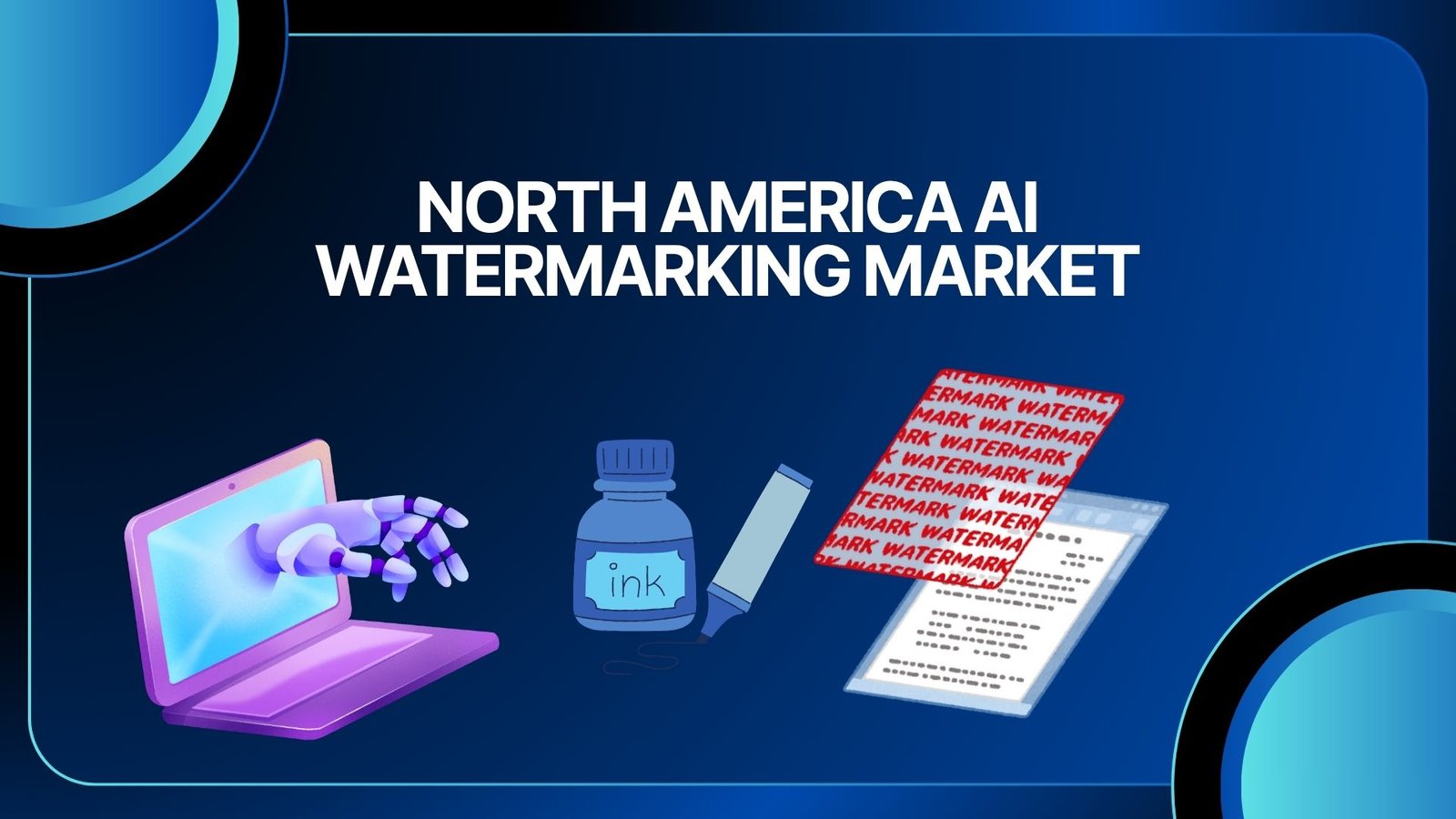Creator Economy Statistics By Market, Demographics And Facts (2025)
Updated · Oct 22, 2025
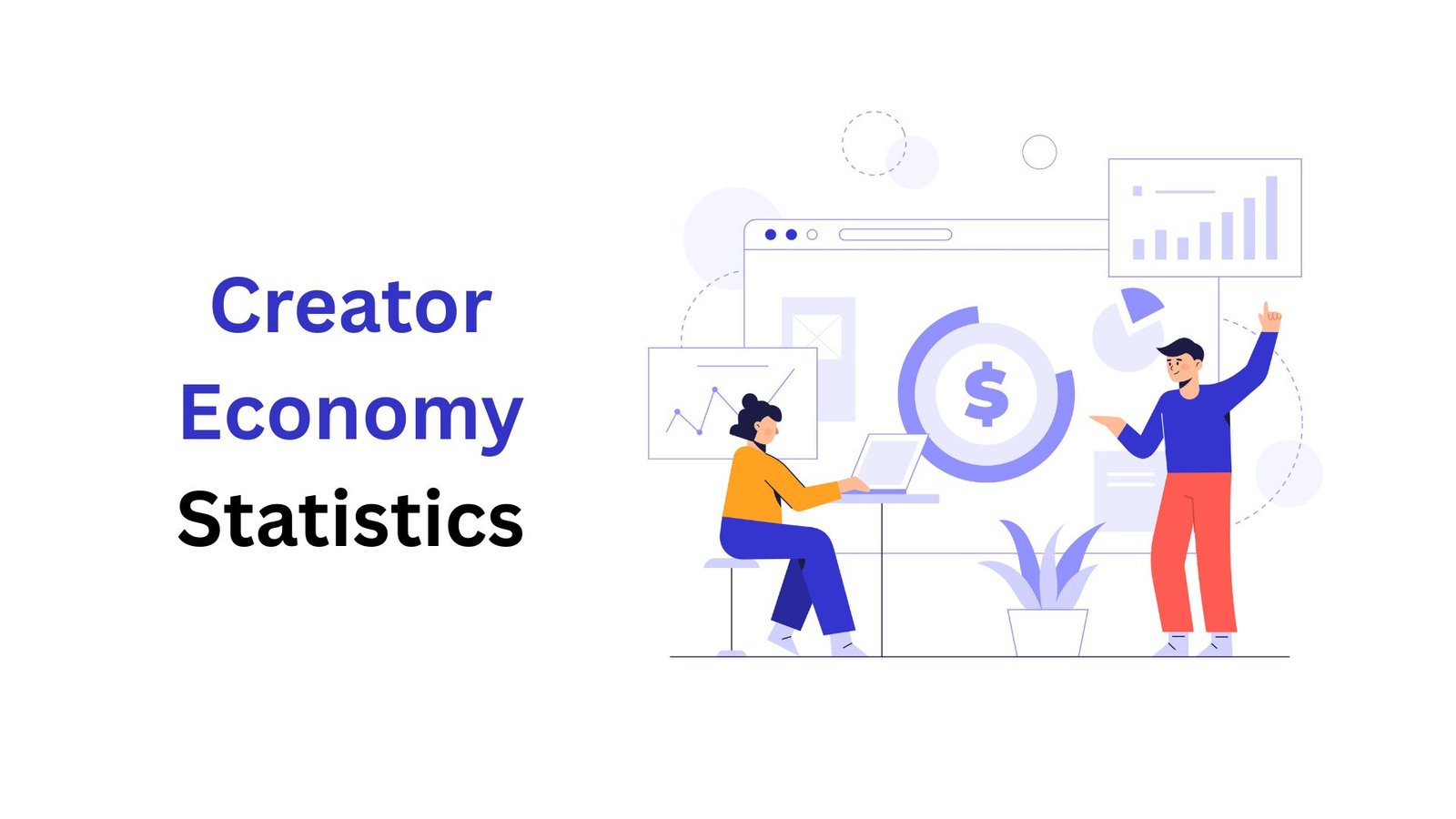
WHAT WE HAVE ON THIS PAGE
Introduction
Creator Economy Statistics: Forget chasing traditional career ladders, because in 2025, the creator economy has exploded into a global economic force, turning individual skills into multi-million dollar digital enterprises.
The backbone of this change is a vast network of individuals, from solo entrepreneurs selling niche e-books to big creators launching global product lines, all leveraging digital platforms to own their audience and their income. These data prove it’s the fastest-growing market in modern digital history, one that has permanently changed work.
I’d like to discuss further the creator economy statistics in this piece of work, diving deep into the latest, most recent data of 2024 and 2025, providing a quantitative roadmap of its unprecedented growth, the distribution of wealth, key creator challenges, and the radical, AI-driven future that lies ahead. Without further ado, let’s get into it.
Editor’s Choice
- $205.25 billion USD, the official market valuation of the global creator economy in 2024, confirming its status as a major global industry.
- $500 billion USD by 2027, the aggressive market projection, indicating the creator economy is expected to more than double in value over the next three years.
- 2% revenue share, the portion of the market revenue generated directly by individual content creators in 2024, demonstrating their dominance over traditional platform or media revenue.
- $55 billion U.S. GDP, the total economic contribution of a single major platform’s creative ecosystem (YouTube) to the U.S. economy in 2024 alone.
- 207 million+ individuals, the vast total number of people worldwide who currently identify as active participants in the creator economy.
- 2% of Gen Z, the overwhelming percentage of this generation who are currently leveraging the creator economy to earn income through a digital side hustle.
- 45 Million Professionals, the estimated number of individuals globally who pursue content creation as a dedicated, full-time career path.
- 74% with a degree, the high percentage of creators who hold a bachelor’s degree or higher, suggesting the industry is attracting high-skill, educated workers.
- 70% of creator revenue, the portion of income that comes directly from high-value brand deals, sponsorships, and affiliate marketing, rather than platform ad revenue.
- $94,731 average annual earnings, the high average income for creators who successfully adopt and monetize a subscription-based revenue model.
- $1,211 average per post, the typical payment rate a Micro-Influencer (10K to 100K followers) can command for a single, sponsored social media post.
- 71% carning $15,000 annually, the critical statistic highlights the massive financial disparity and the struggle for half of the market to achieve sustainable professional income.
- 52% creator burnout rate, the alarming percentage of creators who have experienced burnout, driven primarily by the relentless demand for content and financial instability.
- 46% time on creation, the surprisingly low portion of a creator’s time that is actually spent on content creation, with the majority consumed by admin and marketing tasks.
- 59% use AI tools, the high rate of AI adoption among creators who are leveraging technology to streamline workflows, script content, and improve monetization to 30%.
Creator Economy Market Overview
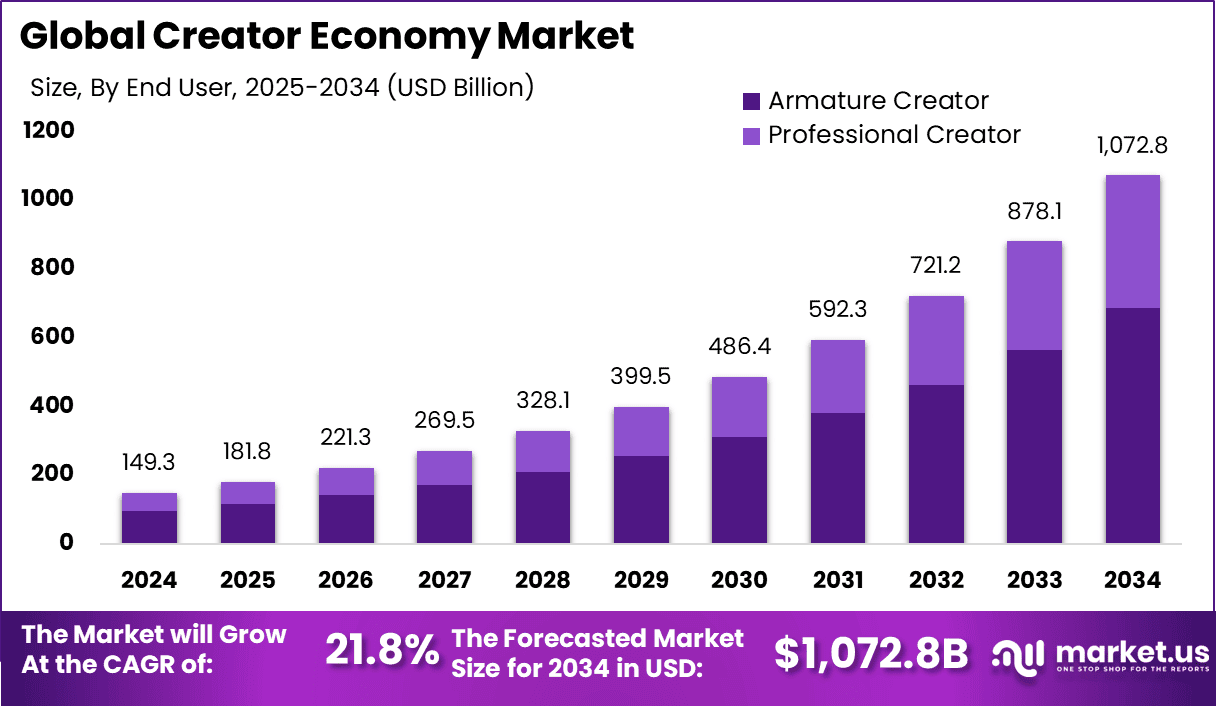 (Source: market.us)
(Source: market.us)
- According to market.us, the global creator economy is projected to grow from $181.5 billion in 2025 to a massive $1,072.8 billion by 2034.
- This represents a high Compound Annual Growth Rate (CAGR) of 21.8% over the forecast period.
- Social media platforms captured 27.8% of the global creator economy in 2024. North America leads in platform-based value, contributing approximately 29% of this segment’s revenue.
- Video content is the leading format, accounting for 23.8% of the market share in 2024. This dominance is driven by the demand for short-form and long-form videos on major platforms like YouTube and TikTok.
- The vast majority of creators are amateur creators, who make up 64.1% of the end-user segment.
- North America currently holds the largest share, commanding 37.4% of the global creator economy in 2024.
- The region generated $55.8 billion in revenue, supported by advanced digital infrastructure and high smartphone use.
- The US creator economy market alone is expected to swell from $50.9 billion in 2024 to $297.3 billion by 2034.
- This projection is based on a CAGR of 19.3%, driven by continuous investment in creator tools and marketing.
- It is estimated that there are now over 400 million creators globally in 2024. Full-time digital creator jobs in the US have surged from 200,000 in 2020 to 1.5 million in 2024.
- Brand deals and collaborations are the main source of revenue, relied upon by 68.8% of creators for income.
- In contrast, only 7.3% of creators primarily depend on traditional ad revenue for their earnings.
- Monetization is diversifying, with advertising income growing by 15%, affiliate marketing by 9%, and merchandise sales by 4%.
| Global Market Value | $181.5 Billion (2025) | Expected to reach $1,072.8 billion by 2034. |
| Growth Rate (CAGR) | 21.8% (2025 to 2034) |
The high growth rate is driven by social media, mobile usage, and content consumption. |
|
US Market Value |
$50.9 Billion (2024) | Projected to reach $297.3 billion by 2034, with a 19.3% CAGR. |
| Total Creators |
400+ Million (2024 Estimate) |
Full-time digital creator jobs in the US have grown to 1.5 million in 2024. |
|
Creator Type Share |
Amateur Creators hold 64.1% | The majority create content for passion or supplemental income. |
| Top Content Format | Video Content leads with 23.8% |
This includes both short-form and long-form video across platforms. |
|
Top Revenue Channel |
Brand Deals are primary for 68.8% of creators | Only 7.3% of creators primarily depend on ad revenue. |
| Regional Share | North America holds 37.4% |
Generated $55.8 billion in 2024 revenue due to advanced infrastructure. |
Creator Economy in the 3D Market
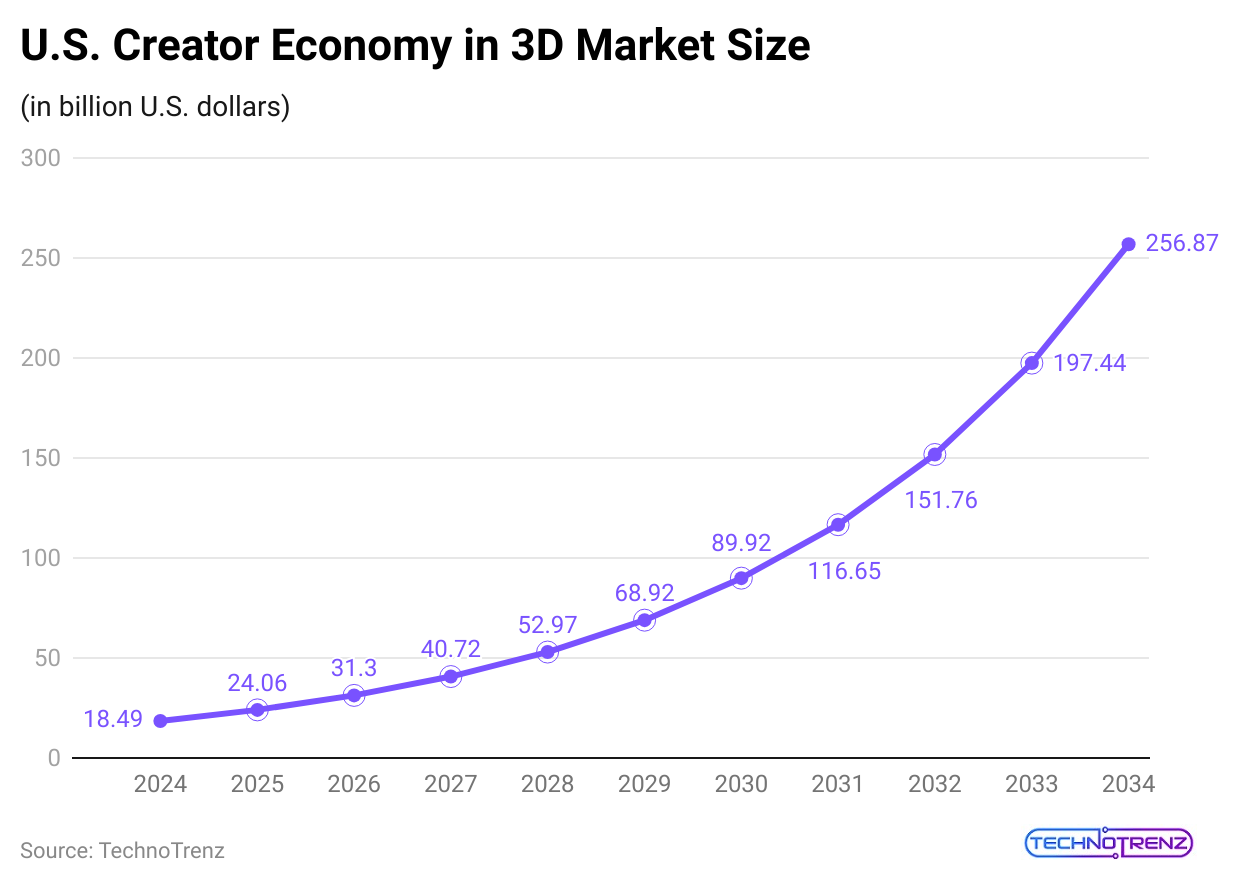 (Reference: market.us)
(Reference: market.us)
- According to market.us, the highly specialized creator economy in the 3D market is forecast to jump from $79.3 billion in 2025 to $971.9 billion by 2034. This dramatic growth is reflected in an exceptionally high CAGR of 32.1%.
- The largest segment is 3D models and assets, which captured 37.4% of the market share in 2024.
- Professional creators hold the largest segment of the 3D market at 43.1% in 2024. This highlights the high skill level required for producing commercial-grade 3D content.
- The gaming and entertainment segment dominates demand, capturing 29.9% of the 3D creator economy in 2024.
- North America is also the leader in the 3D space, holding 38.2% of the market in 2024. The region generated approximately $22.9 billion, driven by its strong technological infrastructure and development.
| Global Market Value | $79.3 Billion (2025) |
| Growth Rate (CAGR) | 32.1% (2025 to 2034) |
| Top Content Segment | 3D Models & Assets holds 37.4% |
| Top Creator Type | Professional Creators hold 43.1% |
| Top Application | Gaming & Entertainment holds 29.9% |
| Regional Share | North America holds 38.2% |
Demographics and Engagement Metrics
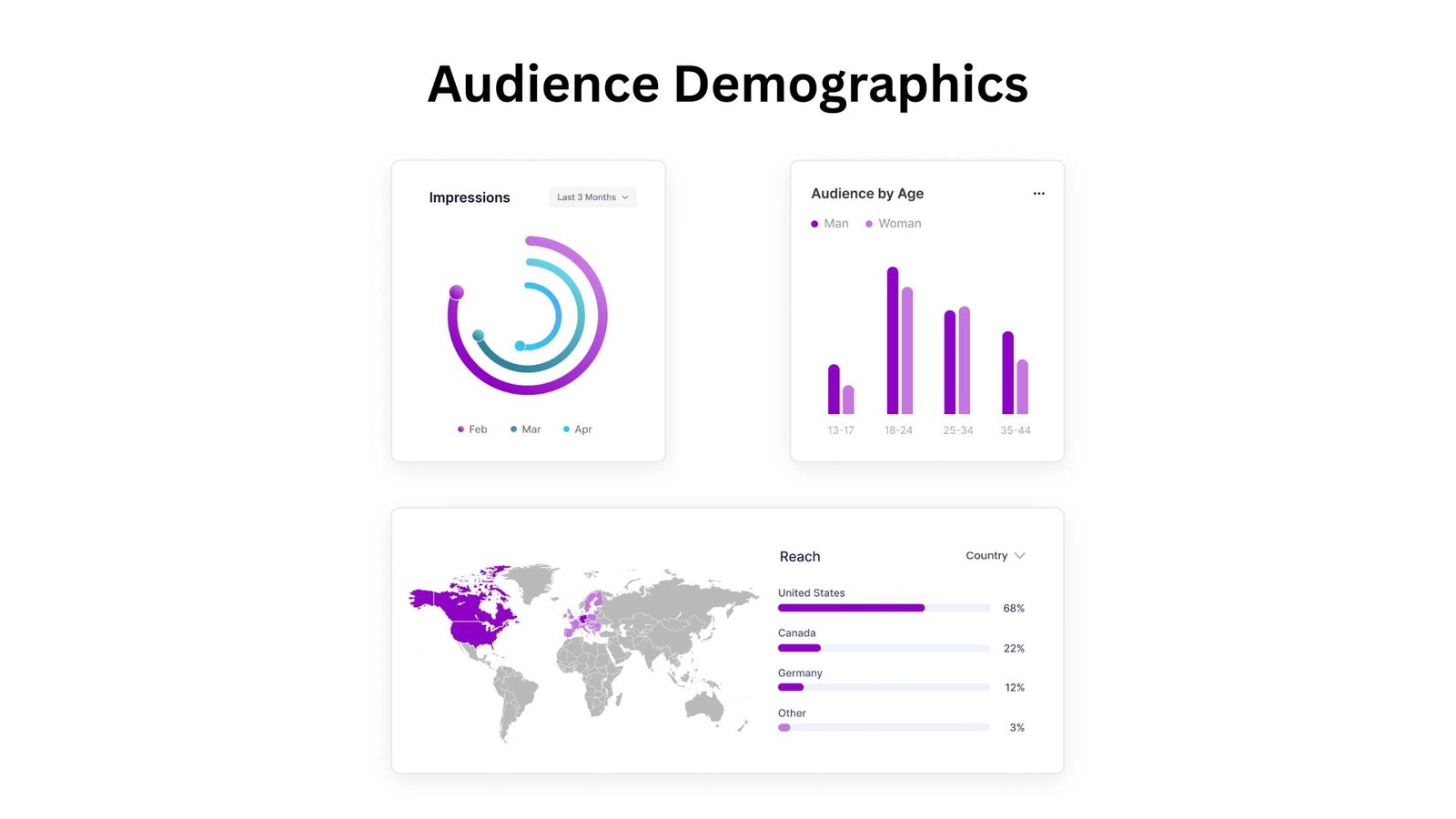 (Source: getphyllo.com)
(Source: getphyllo.com)
- The global creator economy is currently populated by over 207 million individuals who identify as content creators, a number that has swelled dramatically, especially since 2020.
- Of this huge base, an estimated 45 million individuals globally classify themselves as professional, full-time content creators, while a whopping 162 million are active as amateur or part-time creators.
- In the United States alone, approximately 162 million people identify as content creators, demonstrating the overwhelming domestic adoption of this digital career path.
- The demographics skew slightly toward a more balanced gender split than traditionally perceived, with 51% of creators identifying as female and the remaining 49% identifying as male or nonbinary.
- Younger demographics are the main engine of the market, with 65% of all content creators being aged 39 or younger, solidifying the industry as a millennial and Gen Z phenomenon.
- Participation from younger demographics is extremely high: 68.2% of Gen Z is reported to be actively earning an income through a digital side hustle within the creator economy.
- Creators are highly educated, with a significant majority, approximately 74% of creators, possessing a bachelor’s degree, suggesting that high-skill, educated labor is pivoting into content creation.
| Total Global Creators | Over 207 Million |
| Professional (Full-Time) Creators | 45 Million |
| Creators Aged 39 and Under | 65% of the Total |
| Gen Z Earning via Digital Hustle | 68.2% |
| Creators with a Bachelor’s Degree | 74% |
Income Disparity and Monetization
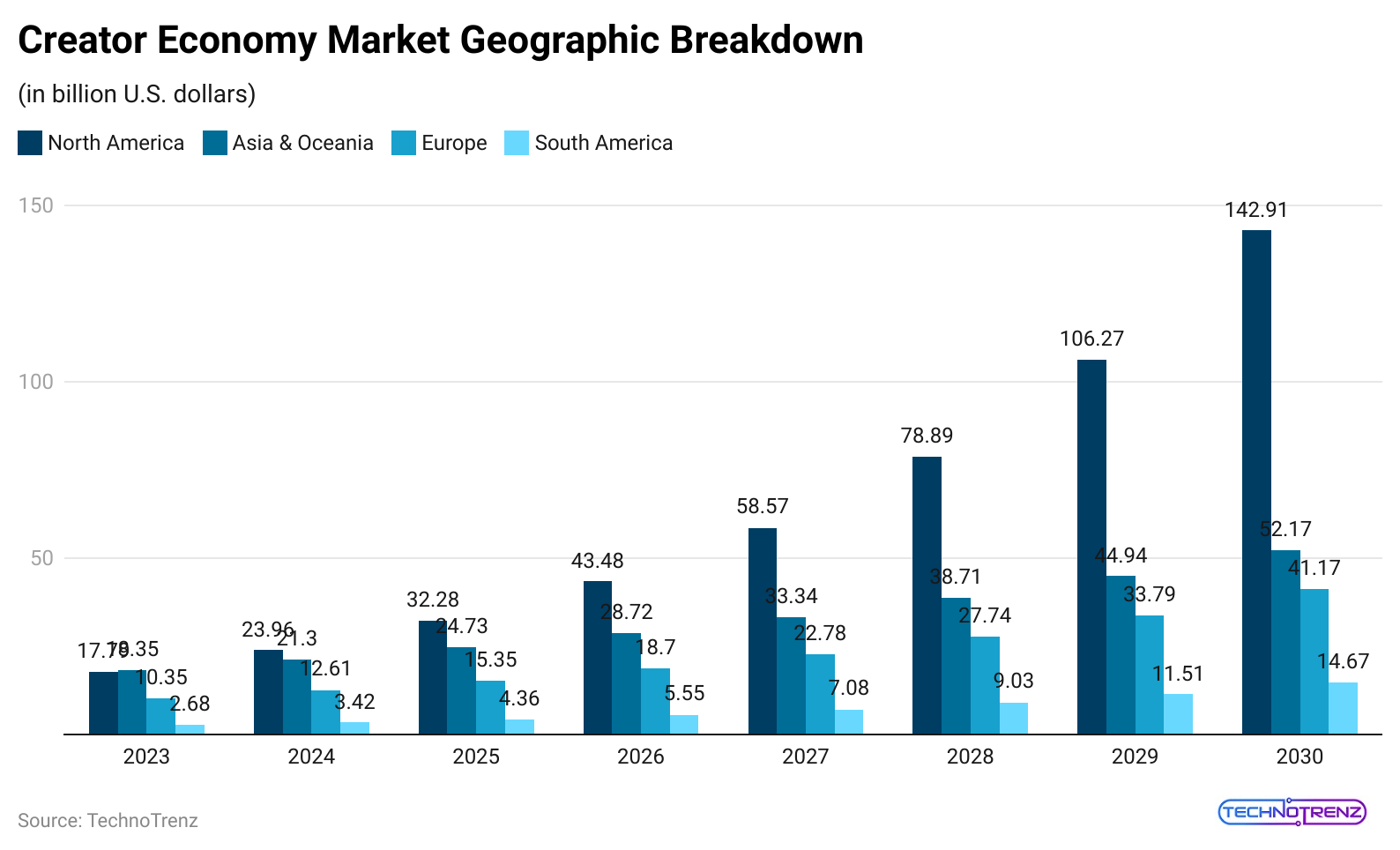 (Reference: explodingtopics.com)
(Reference: explodingtopics.com)
Income Distribution and Tiered Earnings
- The true professionals, defined as the top-tier creators, represent approximately 4% of the total creator population but are responsible for generating over 80% of the market’s total revenue.
- Only a small elite fraction, around 0.96% of all creators, have an audience size of more than 1 million followers, yet these mega-creators command the highest individual pay rates.
- The vast majority of part-time creators struggle in the early stages, with 68% of part-time creators reporting annual earnings of less than $1,000, highlighting the “hobbyist” nature for many participants.
- For creators who are successful enough to use a subscription-based revenue model, the average annual earnings are remarkably high, generating an average of $94,731 over the last 12 months.
- A concerning 50.71% of all influencers earn less than $15,000 annually, a figure that shows the difficulty of moving from a part-time creator to a fully professional one.
- After four years of consistent effort, approximately 80% of creators are making $10,000 or more annually, indicating a significant experience curve.
Revenue by Influencer Tier (Average Rate Per Sponsored Post)
- Nano-Influencers (1K to 10K followers) typically command an average fee of $195 per sponsored post, demonstrating that even small, niche audiences have tangible commercial value.
- Micro-Influencers (10K to 100K followers) see a significant jump, earning an average of $1,211 per post across major platforms, valuing their higher engagement rates with targeted audiences.
- Macro-Influencers (100K to 1M followers) charge an average of $1,804 per post, though high-value video platforms like YouTube can see their earnings soar far above this average.
- On YouTube specifically, a Mid-tier Influencer (50K to 500K subs) can expect to earn between $1,000 and $10,000 per sponsored video, reflecting the higher production value and long-term search value of video content.
- The top 10% of earners on certain subscription video platforms generated $171 million over a recent 12-month period, which breaks down to an average of $582,000 annually per creator in this elite group.
| Top 4% of Creators | Generate 80%+ of Total Revenue |
| Creators Earning $15,000 Annually | 50.71% |
| Average Nano-Influencer Post Rate (1K to 10K) | $195 |
| Average Micro-Influencer Post Rate (10K to 100K) | $1,211 |
| Average Annual Earnings (Subscription Model) | $94,731 |
Revenue Streams and Brand Partnerships
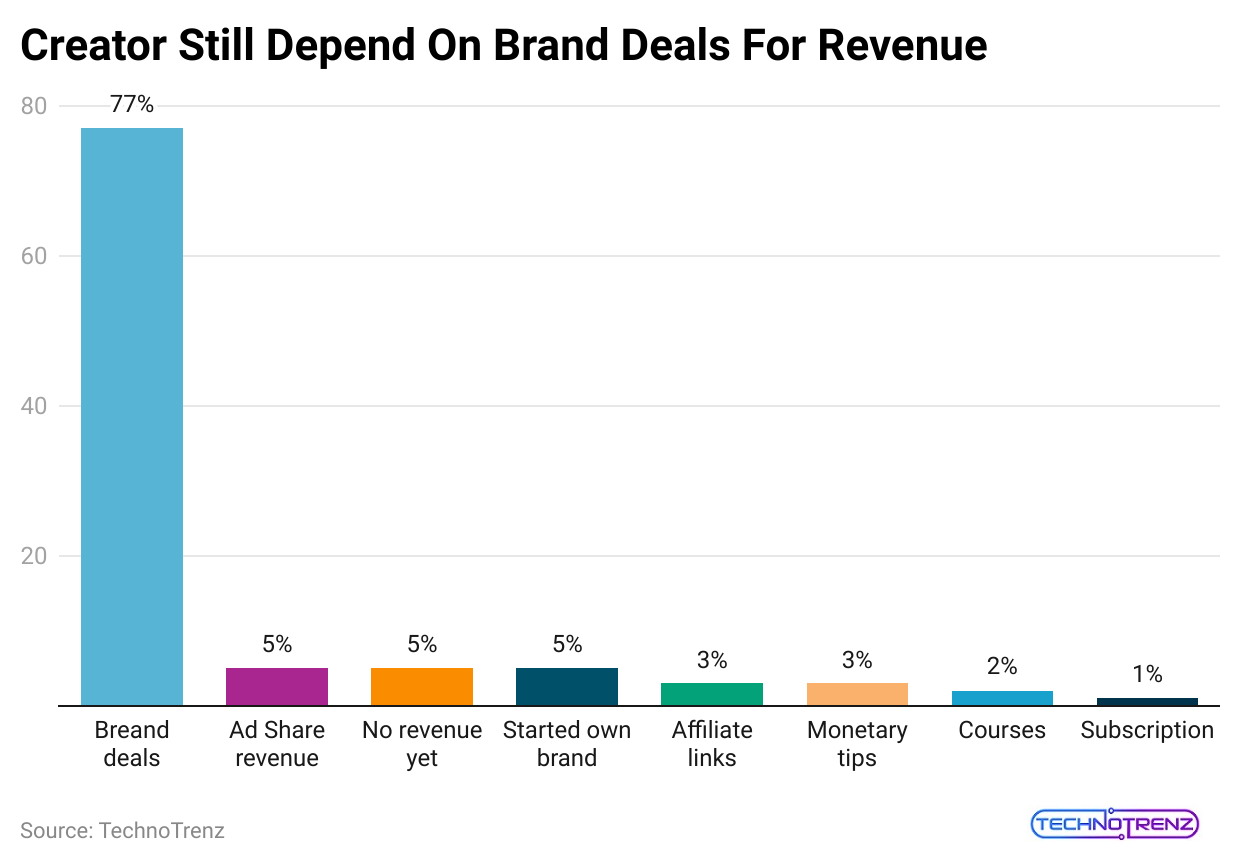 (Reference: grin.co)
(Reference: grin.co)
- Brand partnerships remain the dominant revenue source, with 70% of a creator’s total revenue coming directly from brand deals, sponsored content, and affiliate marketing.
- A significant 92% of marketers agree that sponsored content produced by creators outperforms organic content posted on the brand’s own accounts.
- Approximately 68.8% of creators primarily depend on brand deals for their income, a huge contrast to the 7.3% who primarily rely on traditional platform ad revenue.
- The influencer marketing industry, which is the spending arm of brands on creators, is independently valued at $24.0 billion in 2024, representing a 13.74% increase over the previous year’s value.
- On a major video platform, the top 1% of all creators are responsible for generating 55% of the platform’s total ad and subscription revenue.
- The fastest-growing revenue streams include digital product sales and memberships, with over 130,000 creators using platforms like Payhip to sell everything from e-books to online courses.
- YouTube’s creative ecosystem alone contributed over $55 billion to the U.S. GDP in 2024 and supported more than 490,000 full-time jobs in the US.
| Revenue from Brand Deals | 70% of Creator Revenue |
| Marketer Agreement: Sponsored Content Outperforms | 92% |
| Creators Primarily Relying on Brand Deals | 68.8% |
| Influencer Marketing Industry Value (2024) | $24.0 Billion |
| YouTube Ecosystem Contribution to U.S. GDP (2024) | Over $55 Billion |
Challenges and the Cost of the Hustle
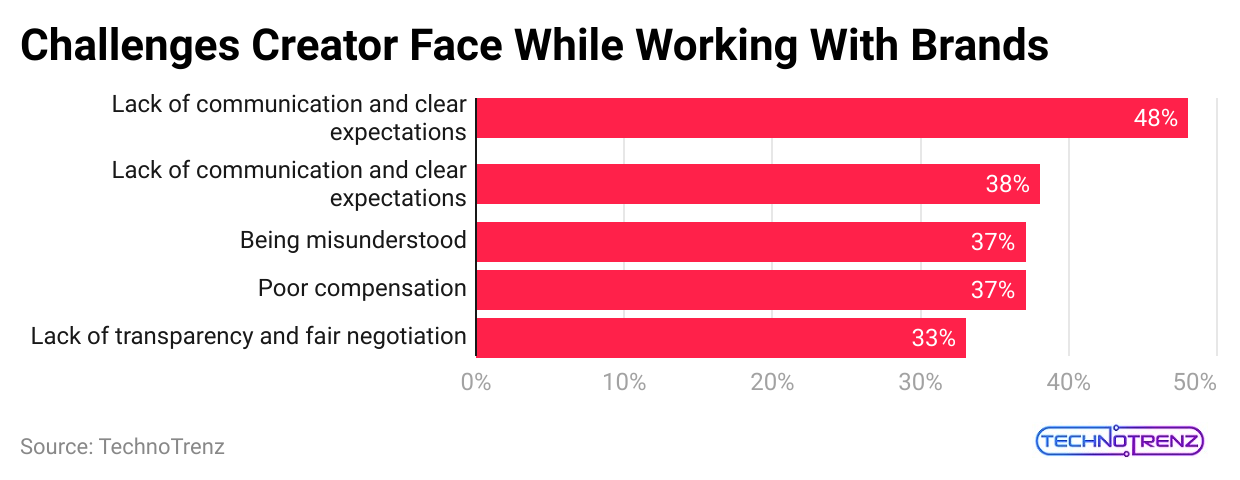 (Reference: simplebeen.com)
(Reference: simplebeen.com)
- A shocking 52% of content creators report having experienced significant burnout directly related to their work, with an alarming 37% considering leaving their careers in the creator economy entirely.
- The number one stressor cited by creators who have experienced burnout is financial instability and income unpredictability, which was named the most severe cause by 55% of respondents.
- Burnout has a measurable impact on well-being, with 59% of creators reporting that it negatively affects their careers and 58% reporting a negative impact on their overall personal well-being.
- A huge barrier for both new and established creators is the administrative workload; only about 46% of a creator’s time is actually spent on the core activity of content creation.
- Creative fatigue is a major trigger for burnout, cited by 40% of creators, due to the constant pressure from algorithms and audiences to produce fresh.
- A majority of creators, 64%, cite growing their audience as their top operational challenge in the currently saturated and highly competitive digital space.
- Despite these significant psychological and professional hurdles, only a tiny fraction of creators, 2%, actually express regret about their choice of career in the creator economy.
| Creators Experiencing Burnout | 52% |
| Considering Leaving Due to Burnout | 37% |
| 1 Burnout Stressor | Financial Instability (55%) |
| Time Spent on Content Creation | Only 46% |
| Top Operational Challenge | Audience Growth (64%) |
Automation and the Evolution of the Creator Economy
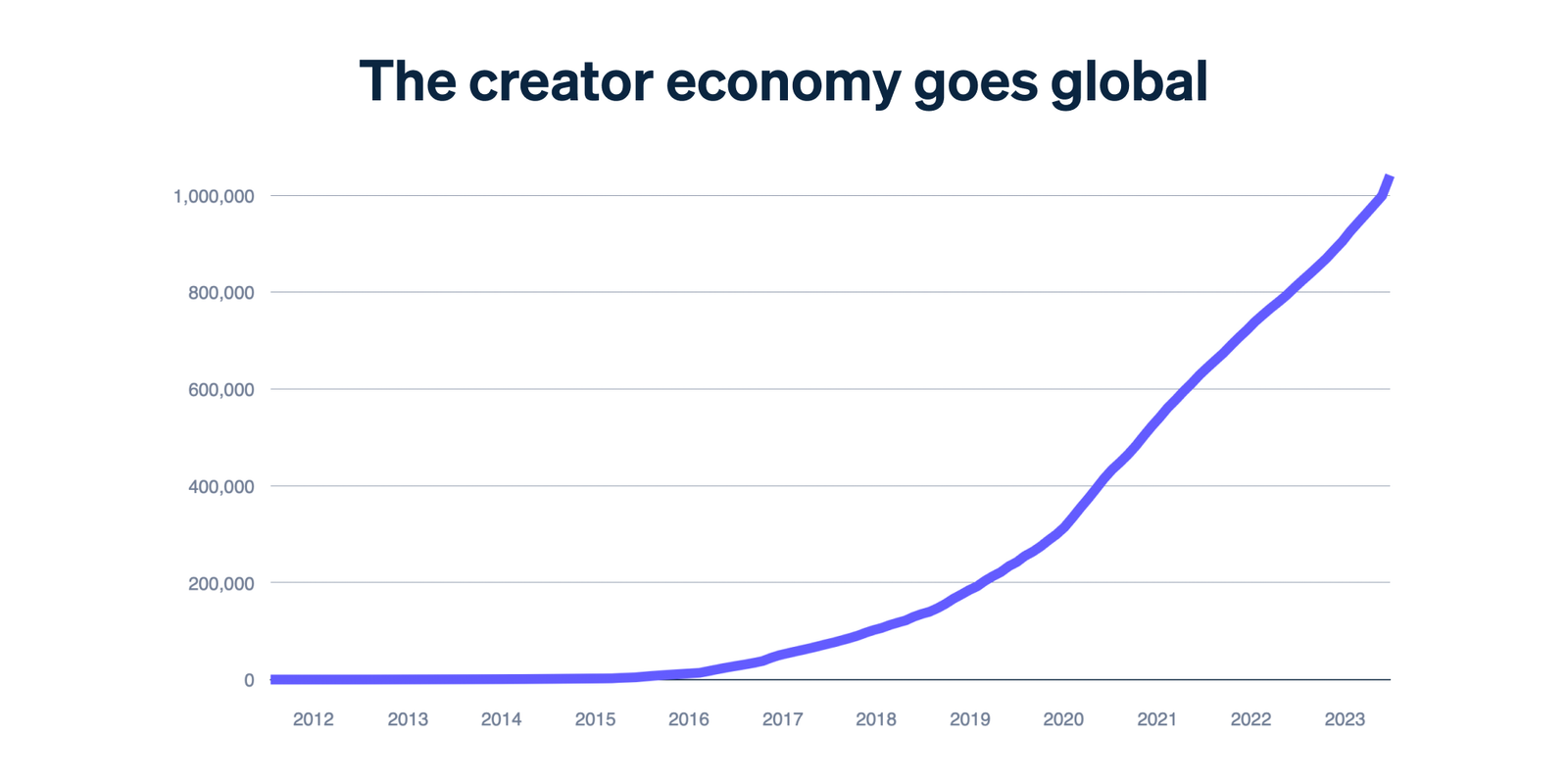 (Source: stripe.com)
(Source: stripe.com)
- Adoption of AI is particularly high among younger professionals: nearly 80% of Gen Z professionals (ages 18 to 21) are currently utilizing AI tools for over half of their work-related tasks, making them the fastest adopters.
- A significant 59% of all creators report that they are now using various AI tools to actively streamline their workflows and enhance their overall monetization strategies.
- Specifically, nearly 63% of content creators are regularly using AI-assisted scriptwriting and content generation tools to drastically speed up the video scripting and initial content drafting process.
- The use of AI is becoming a direct factor in content strategy, with 23% of creators using AI specifically to curate digital products or to analyze complex audience data for better targeting.
- There’s a willingness to invest directly in these enabling tools, a substantial 73% of survey participants aged 18 to 30 personally pay for their own AI tools, signaling a belief in their financial returns.
- For marketers who work with creators, 55% state that their biggest planned use for AI in 2024 is for content creation, followed by SEO data analysis (54%) and image generation (53%).
- This push toward automation is already yielding results, 85% of marketers now believe that generative AI will fundamentally transform content creation in 2024.
| Gen Z Using AI for Half+ of Work | Nearly 80% |
| Creators Using AI to Streamline Workflows | 59% |
| Creators Using AI for Scriptwriting | Nearly 63% |
| Young Professionals Personally Paying for AI Tools | 73% |
| Marketers Believing AI will Transform Content | 85% |
Conclusion
Overall, the creator economy is the definitive entrepreneurial model of the 21st century. It’s an economic machine valued at over $205 billion USD, powered by 207 million individuals who are transforming their passions into diverse and lucrative revenue streams.
This article has laid out a clear statistical case for a market that is fundamentally rewriting the rules of work. While the stark reality of burnout and the enormous income disparity between the top 4% and the rest of the market remain critical challenges, the overall trajectory, a projected doubling to $500 billion USD by 2027, is an indisputable fact.
The creators who succeed are those who move past mere content posting and adopt the strategies of a business owner: diversifying income, investing in tools (like the 59% now leveraging AI), and relentlessly tracking the numerical performance of their output. The age of the individual entrepreneur, with a camera and a laptop, is changing the world, and the data proves it is just getting started. I hope you guys like this article, if you have any questions, kindly let us know, thanks for staying up till the end.

After graduating in Electrical Engineering, Maitrayee moved into writing after working in various technical roles. She specializes in technology and Artificial Intelligence and has worked as an Academic Research Analyst and Freelance Writer, focusing on education and healthcare in Australia. Writing and painting have been her passions since childhood, which led her to become a full-time writer. Maitrayee also runs a cooking YouTube channel.



